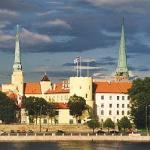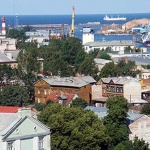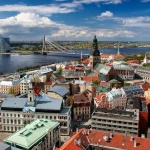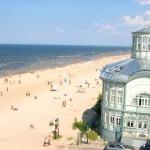Latvia Sights
 Latvia - a country justly proud of its long-standing tourist tradition. Also carefully preserved folk traditions and the architectural masterpieces of Latvian cities, is still warm shores of the Baltic Sea, dozens of modern resorts, nearly fifty of the old castle, the famous amber, hundreds of lakes and mineral springs, as well as many hundreds of square miles of picturesque landscapes.
Latvia - a country justly proud of its long-standing tourist tradition. Also carefully preserved folk traditions and the architectural masterpieces of Latvian cities, is still warm shores of the Baltic Sea, dozens of modern resorts, nearly fifty of the old castle, the famous amber, hundreds of lakes and mineral springs, as well as many hundreds of square miles of picturesque landscapes.Areas of the valley of the Gauja, the banks of the Daugava and Salaca, Vidzeme and Kurzeme coast of the Gulf of Riga, near the village Ergli and Vecpiebalga, "mountains" and Gaizinkalns Sauleskalns, urban neighborhood Tukums and Tulsa, the ancient city of Cesis and Kuldiga, scenic lakes and Esha Reznas - all this is a unique "Necklace of the Baltic", giving the country a unique appearance.
Riga
Riga - the main attraction of this country. The capital was founded in 1201 the knights of the Livonian Order, although people lived in these parts since the early Neolithic. The city's rich history and culture, this architectural landmark in the open air, the center of folk music and a playground for the hundreds of fairs and festivals, Riga on the right is a list of one of the most beautiful cities in Europe.
The main attraction of Riga is a small area Vekriga ( "Old Riga") with dozens of old buildings, among which the most interesting buildings of the small and large guilds (XIX cent.) With gorgeous painting, "Cat House" (1910), with figures of two cats at spiers towers, the palace of Peter the Great, the last bastion of the old city fortress wall - Pulvertornis (Powder Tower, XIII century.) Yakovlevskij barracks building (XVIII century.) Zviedru Vaart (Swedish Gate, 1689) in the size of a tower, the church of St. James (XIII cent.), the residence of the President of the Republic of Latvia - Rigas Pils (Riga Castle, 1330), famous buildings Tris We took (Three Brothers, XV-XVIII cc.), the Church of Our Lady of Sorrow (1764), the Anglican Church of the Savior (1733), Town Hall Square with the statue of the patron saint of the city - St Roland, House of Blackheads "(XIV cent.) opposite the Town Hall, the Orthodox Christmas Cathedral House, Mencendorf (XVII cent.) with the Museum of Life Riga XVII-XVIII centuries. , St. Peter's Church (XII-XIII cc.) with the 137-meter tower and church of St. John (XV-XVI centuries.) yard Convention (the Convention sets, XV cent.) and John's Courtyard (Jana Seta) with a fragment of urban fortification, Freedom Monument (30-ies. XX in.) as well as a number of medieval buildings on the street Trokshnyu, the narrowest street in Riga - Rosen's home in Art Nouveau style on the streets of Albert and picturesque streets tracing paper.
The symbol of the city is the famous Dome Cathedral (1211) with one of the world's largest organ (1884). Also interesting Viesturs garden with established after Russia's victory over Napoleon at the entrance gate of the Alexander, as well as the National Opera (1863), located in the balloon hangars from World War Riga Central Market, the ski resort of Lido, a water park Aqualandia and Park along the city canal. The city has many interesting museums, among which the most interesting military museum in the building of the Powder Tower, the architectural museum in the building of "Three Brothers", Foreign Art Museum, Historical Museum and the Museum of Latvian literature, theater and music at the Riga Castle, the Museum of the History of Riga and Navigation, Latvian Museum of Medicine, the Museum of Culture Dauderi, Nature Museum, Museum of Sport, the only one in the Baltic countries Porcelain Museum, Photography Museum, National Art Gallery of the Latvian Museum of Decorative Arts in the building of the former church of St. George (1204), Museum theater, a synagogue and a Jewish museum in a city suburb Maskavas (gitlerovskry here during the occupation was the ghetto), Riga Motor Museum (Motor Museum), The Railway Museum, Wax Museum, Riga Cinema Museum and the Latvian Ethnographic Museum opened on the lake Yugla with a collection of buildings from all over the country - from wooden churches to windmills XVI-XIX centuries.
In and around the city a lot of modern sports facilities, spa and mud resort Baldone a picturesque park, and in Madona (77 km. South of Riga) is a famous park and the Palace of the Dukes of Courland Rastrelli. The little town of Bauska - www.bauska.lv - (65 km. South of Riga) is known for its castle, the church of the Holy Spirit (XVI century). Mežotne and Palace (XVII century., 10 km. West of Bauska).
Lielupe
Near Lielupe interesting summer residence of the Ambassador of Russia in Latvia and the ultramodern house von Gerkan. In Buldri - Landscape park and lots of old houses. In Dzintari - wooden bath Maksimovic (1906), houses the original architecture Avenue Dzintaru and the famous concert hall Dzintari (1936). In Maiori - estate background Frix and picturesque Juras Street with old houses. In Dubulti should read the sanatorium "Marienbad", the Lutheran church, the gymnasium (1909) and the bank building (1911) original architecture. Jaundubulti known as a place of work of the poet and dramatist Rainis, now here is a museum, giving, dedicated to his work. In Melluzhi - residential building in the style of Romanticism Avenue Strēlnieku house in Art Nouveau style on the street Pukyu and single-storey "family house" in the prospectus Melluzu. Asari is famous for its strawberries, as well as the picturesque old houses on the streets and Ariyas Melluzu. In Kemeri interesting picturesque park (XIX cent.), "White House" (Hotel Kemeri, 1936) and the Lutheran Church (1897). And, of course - amber, beaches, rehabilitation centers, tours, etc. Jurmala is bordered by national park "Kemeri, so eco-tourism here gets increasingly common.
Jurmala
No less famous than the capital, has the Baltic resort of Jurmala (www.jurmala.lv), stretching for 32 kilometers. along the Gulf of Riga, the whole string of resorts and sanatoriums. A healthy climate, cool sea, dunes and pine trees, lots of tennis courts and swimming pools (including well-known water park Aqualandia "and" Nemo "), museums and exhibition halls, entertainment and restaurants, as well as excellent fishing, brought the area deserved reputation as the resort of the heart "of Latvia.
Kurzeme
Kurzeme District - one of four historical regions of Latvia, located in the western part of the country.
Ventspils
Ventspils (www.ventspils.lv) lies on the Baltic Sea 180 km. from the capital. Large industrial and commercial center, he has managed to maintain and its style, and cleanliness of their beaches. Noteworthy molami fenced with established on the outskirts of the southern breakwater beacon (1814, breakwaters themselves provide places for walking and recreation), Ventspils Free Port, the Olympic Sports Complex, one of the best in Eastern Europe, children's amusement park (40 sites!), Ventspils Castle (XIII cent.) with a unique museum, the original fountain, the oldest residential building in the city - Ostgals (1646), Seaside Park (area - 21 ha.) with the Museum of Fisheries and Maritime open-air, water park with three pools and various water attractions "Triangle Cafe on the street Liela and dozens of entertainers. Not far from the city, in Ugāle, is the parish church (XVIII century.) With the oldest organ in the country.
Liepaja
Liepaja (www.liepaja.lv) has been known since 1253, and since 1625 has already received the status of the city. Now this is the third largest city in Latvia, the Special Economic Zone and booming trading port. Interesting pedestrian street Tirgonu, the Church of St. Anne (1508), Trinity Church (1742-1758 gg.) With one of the largest bodies of the world, a concert hall under the open sky "Put, Vējiņi!" ( "Blow, wind!"), St. Nicholas Naval Cathedral, an enormous ice-fields, etc. In Liepaja beautiful sandy beach, the largest park in Latvia - Seaside, which are more than 170 different species of plants and more than 200 wooden houses of XVIII century, among which are the houses of Peter I and Charles XII.
Looking at Liepaja eyes of tourists, so to speak - in the city stopped the passage of time. If there filming a historical movie, it would not have to build sets, makeup fronts, remove the modern paraphernalia in the form of ATMs, advertising Coca-Cola, or too steep automobiles. It is almost completely preserved old buildings the center of the Classical period, virtually no change in the stormy 20 century. Here, whole blocks of old wooden houses, reminiscent of a miracle, preserved areas of Tallinn and Riga, today announced the monuments of wooden architecture. It almost always paved the streets, beautiful parks, many merchant mansions and ... tiny trams, cheerfully sweep the streets.
Karosta
Karosta - a northern suburb of Liepaja, itself a landmark. The road passes through two bridges: the first - through the channel connecting the nearby lake Liepaja (Liepajas ezers) and the Baltic, the second bridge - through Karostsky channel, hitting a few kilometers into the mainland. Earlier in the depths of the channel operated docks of the Soviet Baltic fleet, but the way in these places has been ordered by the majority of citizens.
History Military Camp Karosta has more than 100 years. Even the Russian Tsar Alexander III issued a decree on the tab here seaport. Along with the development and expansion of the port was built on a powerful system of fortifications along the coast of the Baltic. On the territory of the former military camp, to this day, preserved many memorials of those years. First of all - the steel swing bridge built in 1906, and acting to this day. A little further - the impressive Orthodox Cathedral of St. Nicholas, built in 1901.
Not far away - the same military prison, which is a few good-quality 2.3 storey buildings of red brick. One of the first prisoners were sailors who took part in the revolution of 1905, and cemetery on the contrary - has become a place of their last havens, executions carried out directly opposite. During the Soviet era Corps served guardhouse, and after Latvia's independence - a time for the needs of the Latvian army. However, the latter are not settled down and gave all that stuff at the mercy of tourists.
In the prison has a website on the Internet, where a colorfully told and shown about the past and present in prison. It is now a museum open to visitors. Especially for tourists in the cells everything arranged as if there was still contain people. Dirty mattresses, chairs, a metal mug. Administrative compartment, where the offices of the convoy portraits of Lenin, the state-owned metal tables, a police uniform on a hanger.
Just north of the district Karosta is another interesting object - Northern forts. Since its construction in the early 20 th century, this chain of coastal fortifications serve only a few years. In 1908 on the orders of the Russian czar blown up on the occasion of their peace treaty with Germany. And what a strange era befell Russia in this very 20 century? Just over 6 years, Russia and Germany once again become mortal enemies, the destruction of the forts as soon weakened the country, and even a few years ceased to exist and actually Tsarist Russia.
In Kuldiga (first mentioned in documents in 1242) interested in "Stone Bridge" (1874) across the river Venta, the palace Edole (XIII cent.), The ruins of the castle (2.5 km. To the north of the city) and a waterfall "Venta Rumba on the River Venta - the widest in Europe (width of 275 meters with a height of 2 meters). At Tulsa - a medieval castle Dundaga (XIII cent.) And the famous statue of the crocodile ", dedicated Arvydas von Blyumenfeldsu. Also very popular excursion on the river valleys Abava and valves, lock Jaunmoku (1901) with the Museum of the forest not far from Tukums, as well as towns and Kandava Sabile, famous for its vineyards.
Zemgale
Thanks to fertile lands Zemgale region called the "breadbasket of Latvia", and therefore are actively developing rural tourism, is in clean environment and some, just really felt, rest.
Jelgava
Jelgava - www.elgava.lv - (ancient Mitau) was once the capital of the Duchy of Courland. Now it is a beautiful and quiet town, quickly restoring the devastation of the Second World War. Among the noteworthy sights of the city of Jelgava Palace (1737-1740 gg. Now here is the Latvian University of Agriculture), the oldest institution in Latvia - Academy Petrina (XVIII cent.), The temple of St. Simeon, the Lutheran Church of St. Anne and the villa Medem ( 1818).
Vidzeme
Historic District Vidzeme is located north-east of Riga. It extends the excellent Vidzeme coast. In the interest of national Salaspils botanical garden and a memorial concentration camp Salaspils. Island Dole is famous for its natural park (1776) and the Museum of the Daugava River in a residential area Doleskogo estate.
Sigulda
Resort Sigulda (www.sigulda.lv) - "Latvian Switzerland" and one of the most visited cities in Latvia. The city is known for its National Park, Sigulda castle ruins, ancient castle Turaida (XIII cent.), The estate of Prince Kropotkin (XIX century). Turaida with the Lutheran Church (XVIII cent.) Sculpture park, as well as the stunning nature of the valley of the river Gauja. In Sigulda also has one of the best bobsled track world, and even ski center. In the vicinity of the city attractive estate and castle Bīriņi (1860), the palace Igate (1880), an ancient settlement on the lake Araisi Arayshskogo and the ruins of the castle (XIV-XVII centuries)..
Cesis
One of the most charming cities in the region - Cesis (www.cesis.lv), lying in the northern part of Vidzeme Upland, 38 km. from Sigulda. In this ancient city (founded in 1207) come to inspect the mound "Rieksta Kalis (" Nut Mountain ") with the remnants of old fortifications on the streets and Valnu Palasta, famous Cesis Castle (1237-1561), the up to 1,561 g . served as the residence of Master of the Livonian Order, "New Castle" estate of Count Sievers (1777-1878 gg. is now available here Cesis Museum of History), Palace Park (founded in 1812), the Church of St. John (1283) with excellent body and ancient sundial, and the main monument of the city - Victory Monument (1924-1998 gg.). Surrounding the city - one of the most picturesque places in Latvia, besides also having the outputs of the healing mineral waters, so there are many sanatoriums.
Aluksne
In Aluksne (former Marienburg - birthplace of Russia's Empress Catherine I) is a wonderful park (XVIII-XIX cc.), The ruins of the castle (XIV cent.) Museum, "Gluck's Bible", an estate and a mausoleum Fitinghof (now the estate has a small museum) , shafts of old fortifications on the hills around the city, the Lutheran Church (XVIII century.), are excellent as one of the largest lake in Latvia Aluksne and suburban landscapes. Between Aluksne and Gulbene runs another local landmark and the subject of special pride for local residents - the last passenger railway in Latvia. In Stameriena interesting "new" castle (1908). One of the most beautiful in the country, Cesvaine Palace (1890) is located between Gulbene and Madonna, and was badly damaged by fire. Very picturesque, surrounded by a landscape park palace Jumurda and recreation center "Property Jumurda." Loved by tourists and scenic border with Estonia Vidzeme regions, with hundreds of small picturesque farms and pastoral scenery.
Latgale
Region Latgale (Latgale) interesting identity of the people, the unique nature and turbulent history.
Daugavpils
Daugavpils (www.daugavpils.lv), the second largest city of Latvia, lies 230 km. from the capital, near the border with Belarus, Lithuania and Russia. This is a major industrial and transport center of the country, preserved, however, and its historic core, and its beautiful nature. The main sights are Daugavpils fortress (1813-1878 gg.), Peter and Paul Church (1848), Boris and Gleb Church (in 1904, the largest Orthodox church in Lithuania), the natural park Daugavas Loki, a picturesque lake Stropskoe (417.9 ha) and the beautiful pine forests in the vicinity. Near Mezhciems widely used medicinal properties of chloride mineral waters and curative mud, and the number of rivers and lakes suitable for recreation, is huge. To the east of Daugavpils is Kraslava, famous for its kraslavas church (Latgale is the center of Catholicism in Latvia). In Algone is a unique Catholic basilica (1699-1800 gg.) And spread out around the monastery (XVIII century.), Built around the miraculous source and are one of the most important centers of pilgrimage in the country. Latgale cultural-historical museum works in Rezekne. And hundreds and hundreds of rivers and lakes in Latgale, providing all the conditions for active rest in the bosom of nature.


